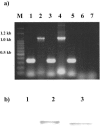CpG-modified plasmid DNA encoding flagellin improves immunogenicity and provides protection against Burkholderia pseudomallei infection in BALB/c mice
- PMID: 16495541
- PMCID: PMC1418635
- DOI: 10.1128/IAI.74.3.1699-1705.2006
CpG-modified plasmid DNA encoding flagellin improves immunogenicity and provides protection against Burkholderia pseudomallei infection in BALB/c mice
Abstract
The plasmid DNA encoding the fliC gene of Burkholderia pseudomallei combined with CpG oligodeoxynucleotide (ODN) was injected intramuscularly into BALB/c mice, resulting in the increased production of certain humoral antibodies and flagellin-specific spleen cell clonal expansion. CpG ODN, as an immunoadjuvant, was added to the plasmid containing the fliC gene in order to obtain ongoing expression in muscle for a long period. Functional expression of flagellin from the constructed CpG-modified plasmid in transfected peritoneal exudate cells of BALB/c mice was shown by reverse transcription-PCR and Western blotting. Furthermore, BALB/c mice immunized with the modified plasmid had relatively higher resistance to B. pseudomallei infection in vivo than did mice immunized with unmodified plasmid DNA. The time course of restricted bacterial growth in spleen and liver and changes in the cytokine profiles of immunized mice suggested that the stimulated phagocytic cells would be able to kill the bacteria eventually, possibly as a consequence of the induction of Th-1-type immune polarization in vivo. Th-1-type immune polarization was detected in response to flagellin induction in mice immunized with CpG-modified plasmid DNA by the appearance of increased levels of immunoglobulin G2a antibodies and gamma interferon-secreting cells specific to flagellin. The exogenous CpG motifs added to the fliC gene would contribute to an adjuvant-like response that enhances the flagellin-specific immunogenicity and provides protection against B. pseudomallei infection. This CpG-modified plasmid DNA vaccination is an important potential strategy that should be developed to protect against melioidosis.
Figures






Similar articles
-
Immunogenicity and anti-Burkholderia pseudomallei activity in Balb/c mice immunized with plasmid DNA encoding flagellin.Vaccine. 2006 Feb 6;24(6):750-8. doi: 10.1016/j.vaccine.2005.08.069. Epub 2005 Sep 6. Vaccine. 2006. PMID: 16169637
-
Immunostimulatory CpG oligodeoxynucleotide confers protection in a murine model of infection with Burkholderia pseudomallei.Infect Immun. 2004 Aug;72(8):4494-502. doi: 10.1128/IAI.72.8.4494-4502.2004. Infect Immun. 2004. PMID: 15271908 Free PMC article.
-
Comparison of the protective effects of killed Burkholderia pseudomallei and CpG oligodeoxynucleotide against live challenge.Vaccine. 2014 Oct 14;32(45):5983-8. doi: 10.1016/j.vaccine.2014.08.035. Epub 2014 Sep 16. Vaccine. 2014. PMID: 25223269
-
Improvement in T helper 1-related immune responses in BALB/c mice immunized with an HIV-1 gag plasmid combined with a chimeric plasmid encoding interleukin-18 and flagellin.Microbiol Immunol. 2015 Aug;59(8):483-94. doi: 10.1111/1348-0421.12274. Microbiol Immunol. 2015. PMID: 26094825
-
Cationic liposomes extend the immunostimulatory effect of CpG oligodeoxynucleotide against Burkholderia pseudomallei infection in BALB/c mice.Clin Vaccine Immunol. 2012 May;19(5):675-83. doi: 10.1128/CVI.05545-11. Epub 2012 Mar 21. Clin Vaccine Immunol. 2012. PMID: 22441390 Free PMC article.
Cited by
-
Development of Burkholderia mallei and pseudomallei vaccines.Front Cell Infect Microbiol. 2013 Mar 11;3:10. doi: 10.3389/fcimb.2013.00010. eCollection 2013. Front Cell Infect Microbiol. 2013. PMID: 23508691 Free PMC article. Review.
-
Burkholderia vaccines: are we moving forward?Front Cell Infect Microbiol. 2013 Feb 5;3:5. doi: 10.3389/fcimb.2013.00005. eCollection 2013. Front Cell Infect Microbiol. 2013. PMID: 23386999 Free PMC article. Review.
-
Immune responses following DNA vaccination by needle-free injection against Burkholderia pseudomallei hemolysin co-regulated protein 1.Front Immunol. 2025 Jun 25;16:1612540. doi: 10.3389/fimmu.2025.1612540. eCollection 2025. Front Immunol. 2025. PMID: 40636117 Free PMC article.
-
Distribution of melioidosis cases and viable Burkholderia pseudomallei in soil: evidence for emerging melioidosis in Taiwan.J Clin Microbiol. 2010 Apr;48(4):1432-4. doi: 10.1128/JCM.01720-09. Epub 2010 Feb 10. J Clin Microbiol. 2010. PMID: 20147639 Free PMC article.
-
Immune response to recombinant Burkholderia pseudomallei FliC.PLoS One. 2018 Jun 14;13(6):e0198906. doi: 10.1371/journal.pone.0198906. eCollection 2018. PLoS One. 2018. PMID: 29902230 Free PMC article.
References
-
- Brett, P. J., and D. E. Woods. 2000. Pathogenesis of and immunity to melioidosis. Acta Trop. 74:201-210. - PubMed
-
- Chaowagul, W., N. J. White, D. A. Dance, Y. Wattanagoon, P. Naigowit, T. M. Davis, S. Looareesuwan, and N. Pitakwatchara. 1989. Melioidosis: a major cause of community-acquired septicemia in northeastern Thailand. J. Infect. Dis. 159:890-899. - PubMed
Publication types
MeSH terms
Substances
LinkOut - more resources
Full Text Sources
Other Literature Sources

